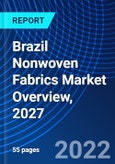This report comes with 10% free customization, enabling you to add data that meets your specific business needs.
1h Free Analyst TimeSpeak directly to the analyst to clarify any post sales queries you may have.
According to the research report Canada Nonwoven Fabrics Market Overview, 2027 it is expected to grow, but at a very slow pace over the forecast period. The most common polymer type is polypropylene, but polyester, biopolymers, and natural fibres are expected to drive future nonwoven Fabrics demand. Single-layer nonwoven Fabricss are in great demand. Spun bond and dry-laid technologies are mostly used to produce nonwoven Fabrics. Hygiene, building and construction, and medical industries have large-scale applications.
Polypropylene is the most widely used nonwoven Fabrics as it is a lightweight synthetic material that is inexpensive, durable, breathable, water resistant, and recyclable, as a result of which it is the most widely used nonwoven Fabrics. PP is generally considered non-toxic and the safest for human contact. PP is used in a broad range of applications and is available in many forms. Nonwoven polypropylene is used in masks because it is nontoxic, breathable, hydrophobic (water-resistant), lightweight, provides filtration, and is inexpensive. Hence, polypropylene nonwoven Fabrics has large-scale application in various industries.
Spun bond technology is generally used to make nonwoven Fabricss. Nonwoven Fabricss are made up of the continuous process of fibres spun and directly dispersed into a web-like deflector or can be directed with air streams. This process leads to a faster belt speed. Basically, these are prepared in a sheet or web structure bonded by entangled fibres or filaments by thermal or chemical treatments, as required by the spun bond Fabrics supplier or spun bond Fabrics manufacturer. It is made of low linear density polyethylene with a high branching ratio; it has good flexibility, water permeability, resistance, softness, and low-temperature resistance; and it also has features like being water-resistant or waterproof. Spun bond nonwoven Fabrics if made biodegradable, the raw materials would be twice as costly.
Nonwoven Fabricss are highly used in hygiene products as they have excellent absorption, softness, smoothness, stretchability, comfort and fit, strength, lotions can be added for specific uses, and good uniformity. Users of absorbent hygiene products benefit from the softness, smoothness, leakage prevention, strength and protection provided by nonwovens. Nonwovens are used in baby diapers, feminine hygiene, adult incontinence, and personal care products. They are used in multiple elements of the products. such as top sheet or cover stock, leg cuff, acquisition/distribution layer, core wrap, back sheet, stretch ears, landing zone, dusting layer, and fastening systems.
Considered in this report:
- Geography: Canada
- Base year: 2021
- Estimated year: 2022
- Forecast year: 2027
Aspects covered in this report
- Canada Nonwoven Fabrics market with its value & volume and forecast along with its segments
- Various drivers and challenges
- On-going trends and developments
- Top profiled companies
- Strategic recommendation
By Polymer Type in the report:
- Polypropylene
- Polyethylene
- PET
- Wood pulp
- Rayon
- Others (PA, PC, polyester, natural fibres, biopolymers)
By Layer Type in the report:
- Single-layer
- Multilayer
By Technologies in the report:
- Spun bond
- Wet laid
- Dry laid
- Others (electrostatic spinning and flash-spun)
By Application in the report:
- Hygiene
- Medical
- Filtration
- Automotive
- Building & Construction
- Others








